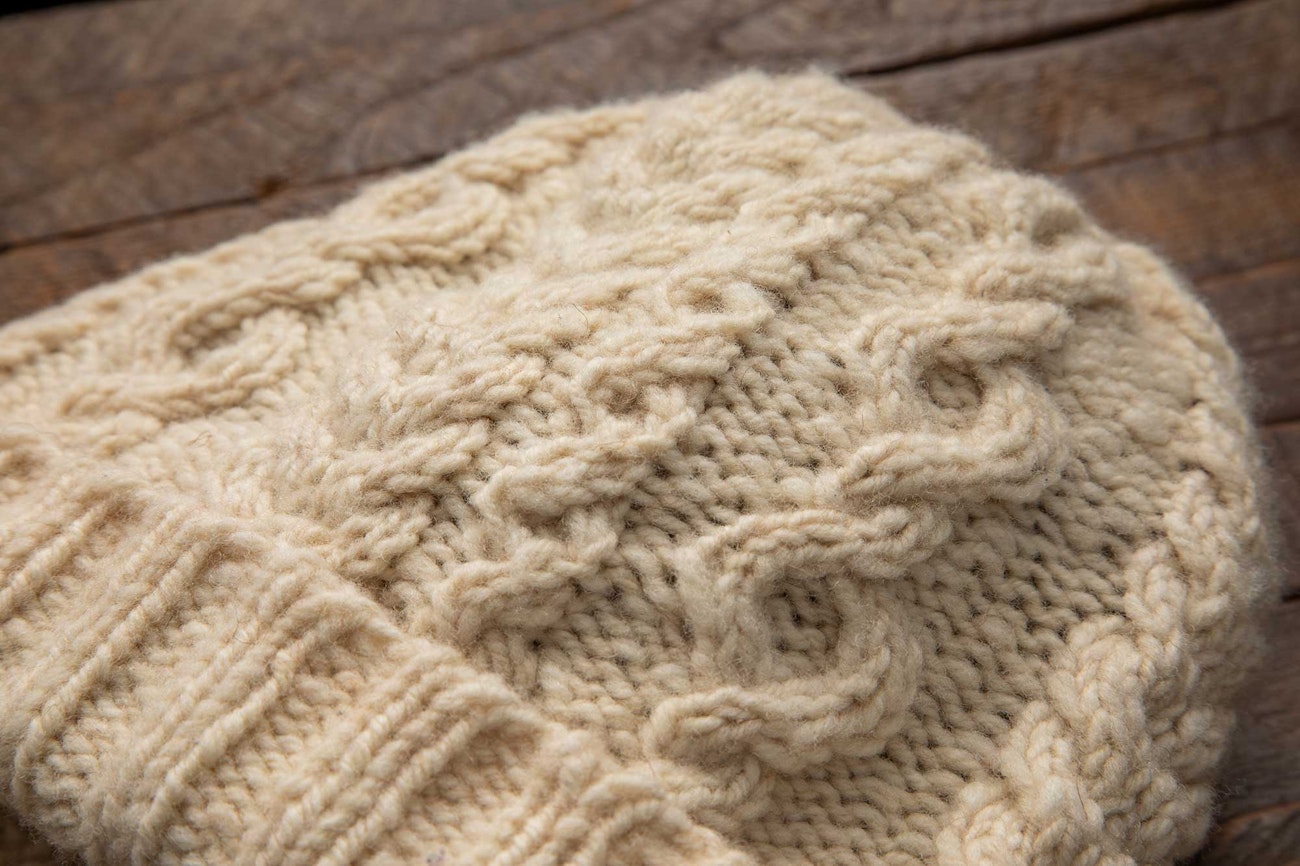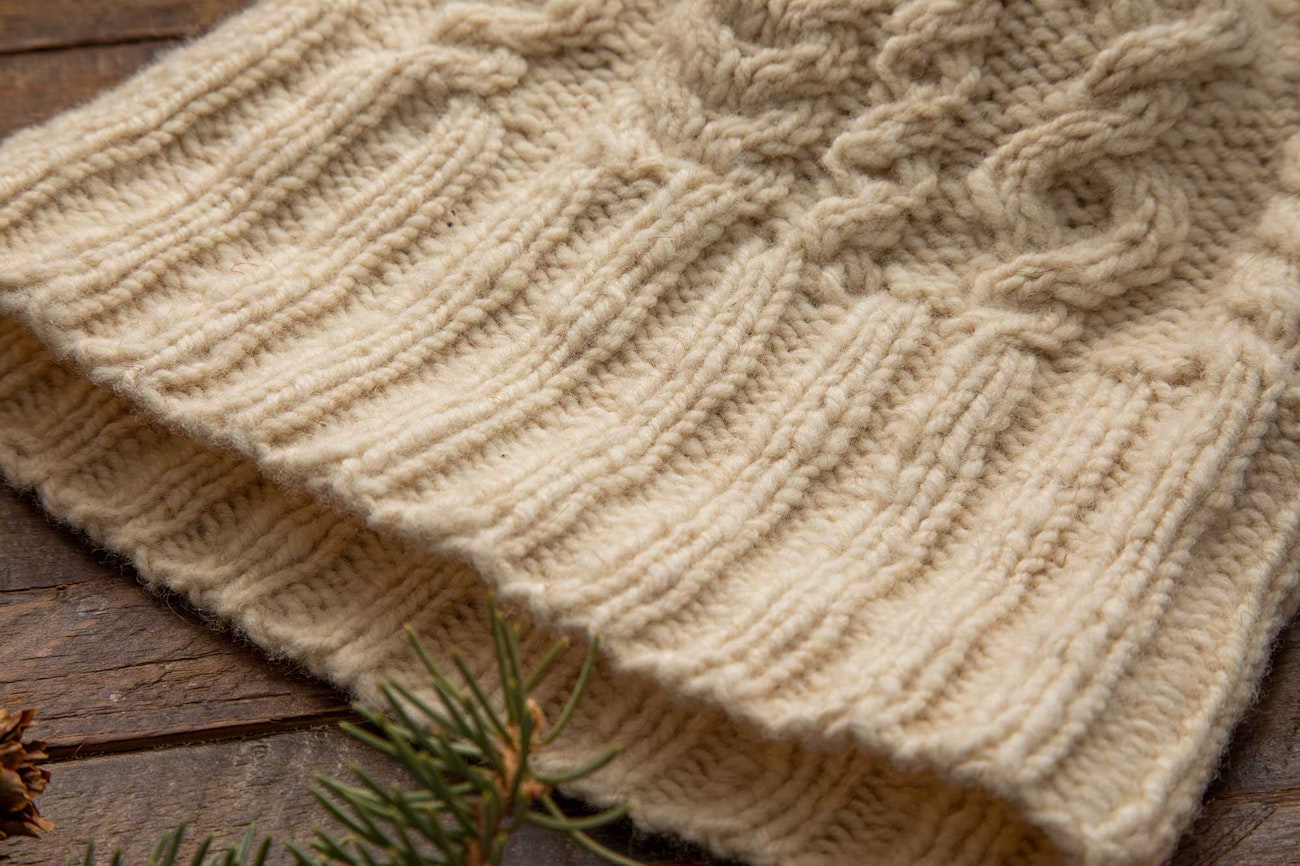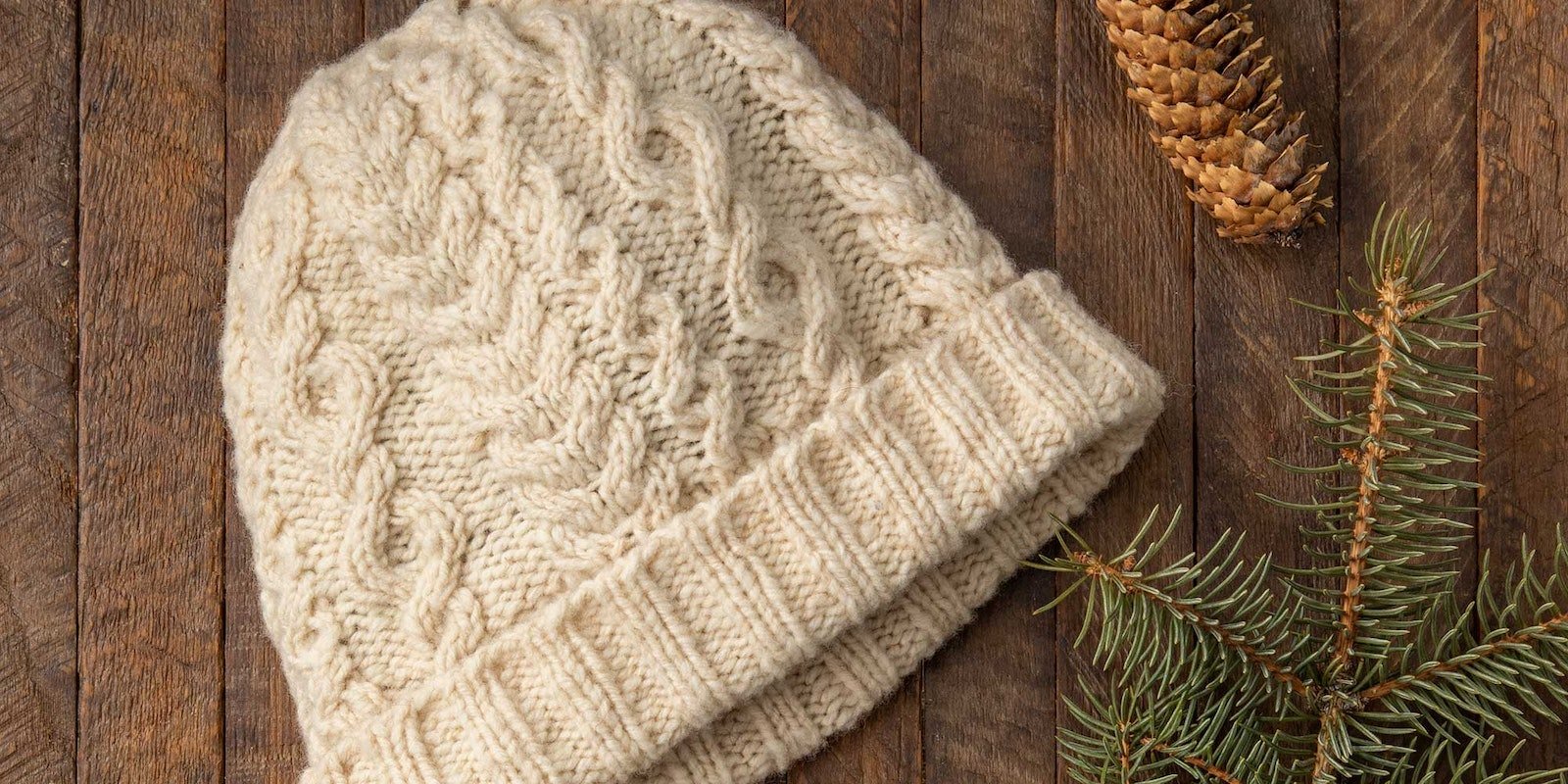https://farmfiberknits.com/cdn-cgi/image/format=auto/https://www.datocms-assets.com/101500/1686594053-towline-hat-header.jpeg?auto=format&w=900
The Towline Hat started with a spinning challenge. I had joined the Shave ‘Em to Save ‘Em program, a challenge for crafters run by The Livestock Conservancy to encourage use of rare and endangered heritage sheep breeds, and Tunis was one of the wools I needed to fill my passport. Tarheelbilly Farm is a Shave ‘Em to Save ‘Em participating farm that has raised Tunis sheep since 2017. I live in North Carolina, and I liked that the farm had a North Carolina connection: Charis Walker, the “Tarheel” in the farm’s name, was raised here. I bought five ounces of her Tunis lambswool roving for my project.
Tunis is one of the oldest sheep breeds, originating in North Africa and said to date to biblical times. The first Tunis sheep arrived in the United States in 1799 as a gift to the new country government from the Bey of Tunis. They are a dual purpose-breed, meaning they are raised for both wool and meat, and they produce a medium-soft wool that starts out reddish at birth and gradually changes to a creamy white. Tunis sheep are particularly well adapted to hot, humid climates. Many of the original Tunis flocks in the United States were destroyed during the Civil War, and they are now listed in the Watch category by The Livestock Conservancy.
 Tunis lambs are born with a red coat, but it is quickly replaced with creamy white wool. Photo by Charis Walker
Tunis lambs are born with a red coat, but it is quickly replaced with creamy white wool. Photo by Charis Walker
[PAYWALL]
The wool was pleasantly soft and bouncy, and I spun an Aran-weight yarn that seemed made for cables. The yarn reminded me of a hat I had purchased about 20 years before from an Irish shop in Jim Thorpe, Pennsylvania. My mother had a similar hat, a natural cream-colored cabled hat featuring stitches like those found in Aran sweaters. So the idea to design a hat was born. The natural bounce of the wool and the three-ply yarn structure give a nice roundness and height to the cables. You may find that there’s a narrower range of needle sizes and gauges that are a good fit for for these yarns.
I knew I wanted a hat that would work for the coldest days here in central North Carolina, with a deep ribbing that could be folded over to keep the ears warm. Since cables tend to pull in the fabric, I cast on fewer stitches for the ribbing section, increasing for the cables on the last ribbing row, and used an alternate cable cast-on to ensure the edge would be stretchy enough.
Three cable motifs are worked around the hat and gradually merge as the crown is decreased. There is always some trial and error when charting the crown decreases; I started by first eliminating purl stitches, then reduced the size of the largest cable to maintain the cable pattern as long as possible. The cable section can be worked from the charts or written instructions.
I chose the name Towline as a nod to the rope-like cables and the Irish fisherman sweaters that served as my inspiration.
Resources
Robson, Deborah and Carol Ekarius. The Fleece & Fiber Sourcebook. North Adams, MA: Storey Publishing, 2011.
Tarheelbilly Farm
Tarheelbilly Farm Farmstead Tunis Yarn

The bouncy, creamy white wool is the perfect canvas for a classic cable pattern. Photos by Matt Graves
MATERIALS AND PATTERN
Yarn Tarheelbilly Farm Farmstead Tunis Yarn (100% American Tunis wool; 200 yd [183 m]/3¼ oz; worsted weight): 2 skeins. [PAYWALL]
Needle Size 7 (4.5 mm) 16" (40 cm) circular and set of dpns. Adjust needle size if necessary to obtain the correct gauge.
Notions Marker (m); cable needle; tapestry needle.
Gauge 23 sts and 30 rnds = 4" in Cable patt, blocked.
Sizes S/M (L/XL), to fit 18"–21" (22"–24") head circumference.
Finished Size 17" (21¼") circumference x 10¼" long with brim unfolded.
Visit farmfiberknits.com/abbreviations for terms you don’t know.
Download this pattern as a PDF here: Towline Hat
Notes
- The smaller size will stretch to fit up to a 22" head circumference with a snug fit. If you prefer a looser fit, choose the larger size.
- Because both handspun and small-batch yarns can vary in grist, be sure to swatch before casting on. You may need to experiment with different needle sizes, choose the smaller or larger pattern size, or add or subtract pattern repeats to obtain the perfect fit.

The ribbed brim is designed to be folded up when worn. Work fewer rounds of ribbing if you prefer a short brim.
STITCH GUIDE
Alternate Cable Cast On
Place a slipknot on left needle. Insert right needle knitwise into slipknot, wrap yarn as if to knit, and pull through, placing new stitch on left needle. You now have 2 stitches on the left needle. * With yarn in front (wyf), slip right needle between the first two stitches on left needle from the back, wrap as for a purl stitch, and pull through, placing stitch on left needle; with yarn in back (wyb) slip right needle between the first two stitches on the left needle from the front, wrap as for a knit stitch, and pull through, placing stitch on left needle. Repeat from * until you have the desired number of cast-on stitches on the left needle.
Alternate Cable Cast On for 2×2 Rib
Work alternate cable cast on, above. You will have a series of alternating knit and purl stitches on the left needle, ready to work 1×1 rib. To set up for 2×2 rib, work the first row flat, as fol-lows: * K1, sl 2nd st on left needle to right needle, dropping 1st st; place 1st st and then the 2nd st (in reverse order) back on left needle, k1, p2. Repeat from * until all stitches have been worked, treating the slipknot as a purl stitch.
Cable Pattern (multiple of 24 sts)
Rnd 1 [P3, k4] 2 times, p1, k8, p1.
Rnd 2 P3, 2/2 RC, p3, 1/1 LC, 1/1 RC, p1, 2/2 RC, 2/2 LC, p1.
Rnd 3 Repeat Rnd 1.
Rnd 4 P3, k4, p3, 2/2 RC, p1, k8, p1.
Rnd 5 Repeat Rnd 1.
Rnd 6 P3, 2/2 RC, p3, 1/1 RC, 1/1 LC, p1, 2/2 RC, 2/2 LC, p1.
Rnd 7 Repeat Rnd 1.
Rnd 8 P1, 2/2 RPC, 2/2 LPC, p1, 1/1 LC, 1/1 RC, p1, k8, p1.
Rnd 9 P1, k2, p4, k2, p1, k4, p1, k8, p1.
Rnd 10 P1, k2, p4, k2, (p1, 2/2 RC) 2 times, 2/2 LC, p1.
Rnd 11 Repeat Rnd 9.
Rnd 12 P1, 2/2 LPC, 2/2 RPC, p1, 1/1 RC, 1/1 LC, p1, k8, p1.
Crown Pattern
Rnd 1 P2, k4, p2tog, p1, k4, k2tog, k7, p2tog—84 (105) sts.
Rnd 2 P2, 2/2 RC, p2, 1/1 LC, 1/1 RC, 2/2 RC, 2/2 LC, p1.
Rnd 3 P2tog, k4, p2tog, k11, ssk—72 (90) sts.
Rnd 4 P1, k4, p1, 2/2 RC, k8.
Rnd 5 [K2tog, k3] 2 times, k2tog, k4, ssk—56 (70) sts.
Rnd 6 2/2 RC, 1/1 RC, 1/1 LC, 2/1 RC, 2/1 LC.
Rnd 7 *K2tog; rep from * to end—28 (35) sts.
HAT
Brim
Using Alternate Cable Cast On for 2×2 Rib (see Stitch Guide), or your preferred cast on for rib-bing, CO 88 (112) sts. Place marker (pm) and join in the rnd.
Rnd 1 * K2, p2; repeat from * to end.
Continue working in 2×2 rib as established for 27 more rnds or until hat measures 4" from cast-on edge.
Body
Size S/M only
Inc rnd K2, p2, M1, * [k2, p2] 3 times, M1; repeat from * to end—96 sts.
Size L/XL only
Inc rnd [K2, p2] 2 times, M1, * [k2, p2] 4 times, M1; rep from * to last 8 sts, [k2, p2] 2 times, M1—120 sts.
Both Sizes
Work Rnds 1–12 of Cable patt 3 times or until hat measures 8¾" from CO, ending with Row 12. Hat should measure approximately 1½" less than desired length.
Crown
Remove m, sl 1st st pwise to right needle, replace m. Work Rnds 1–7 of the Crown, switching to dpns when the circumference becomes too small—28 (35) sts after Rnd 7.
Next rnd * K2tog; rep from * to last 0 (1) st(s), k0 (1)—14 (18) sts.
Final dec rnd * K2tog; repeat from * to end—7 (9) sts rem.
FINISHING
Break yarn, leaving a tail about 6" long. Thread tail through remaining stitches twice and bring to inside of hat.
Weave in ends. Block to measurement.
Kerry Bullock-Ozkan is a knitwear designer and textile artist living in the beautiful Piedmont region of North Carolina. She loves working with local fibers and breed-specific wool to create modern, wearable garment and accessory designs. Follow her adventures in spinning all the breeds at bullockozkandesigns.com.
 Tunis lambs are born with a red coat, but it is quickly replaced with creamy white wool. Photo by Charis Walker
Tunis lambs are born with a red coat, but it is quickly replaced with creamy white wool. Photo by Charis Walker 


